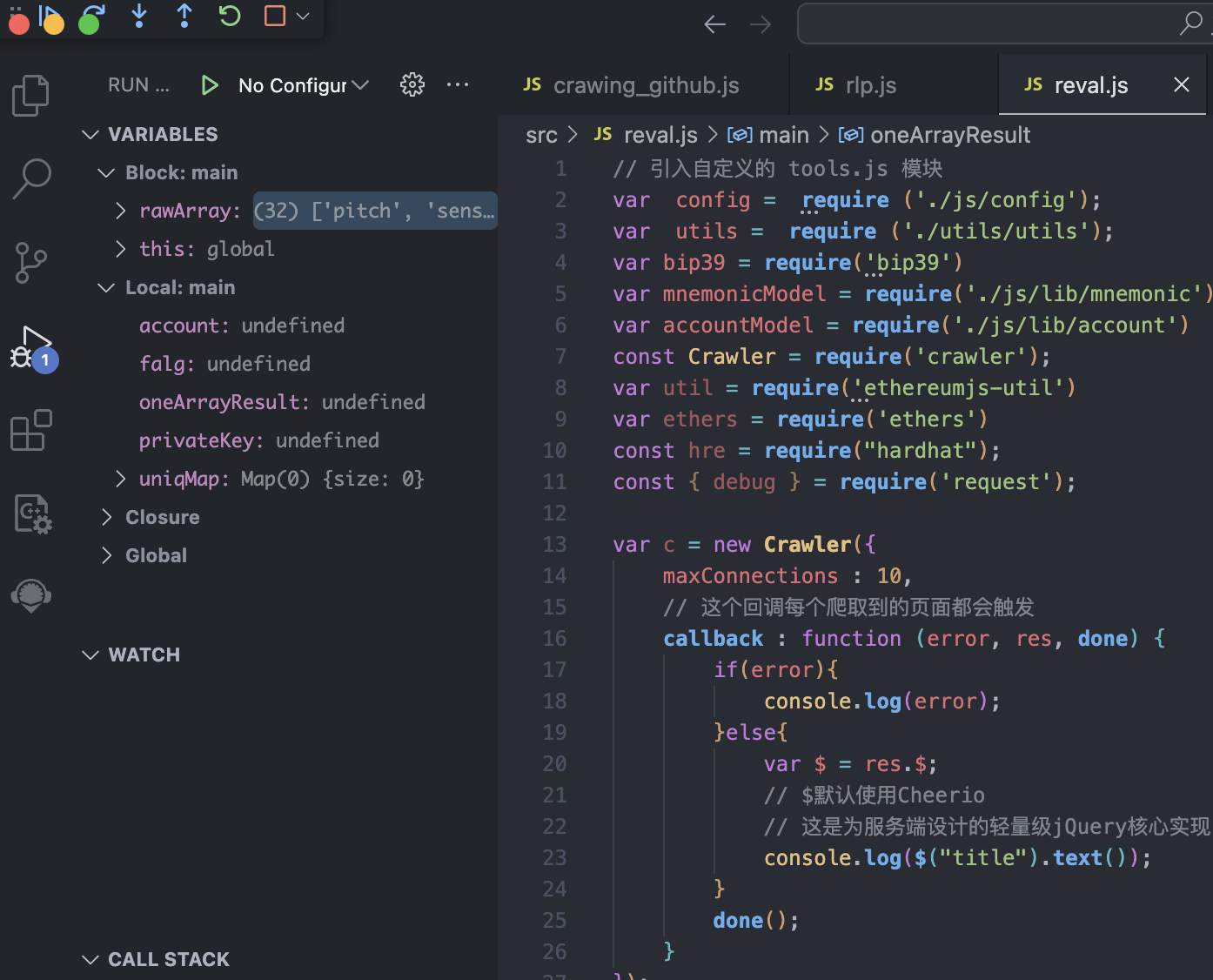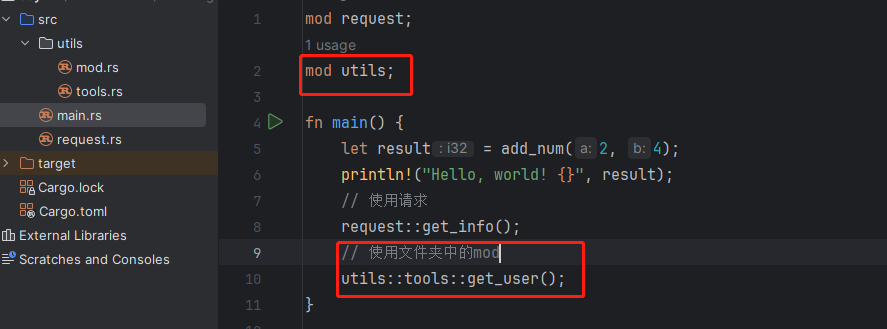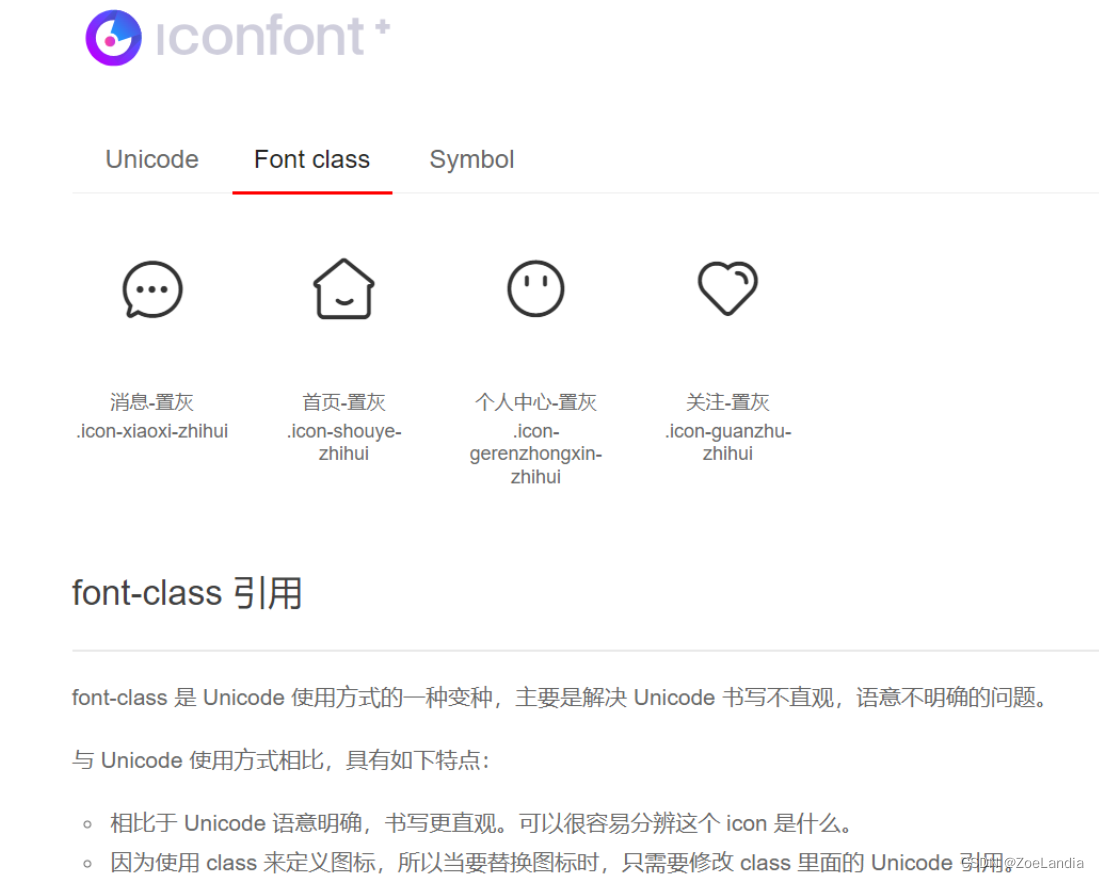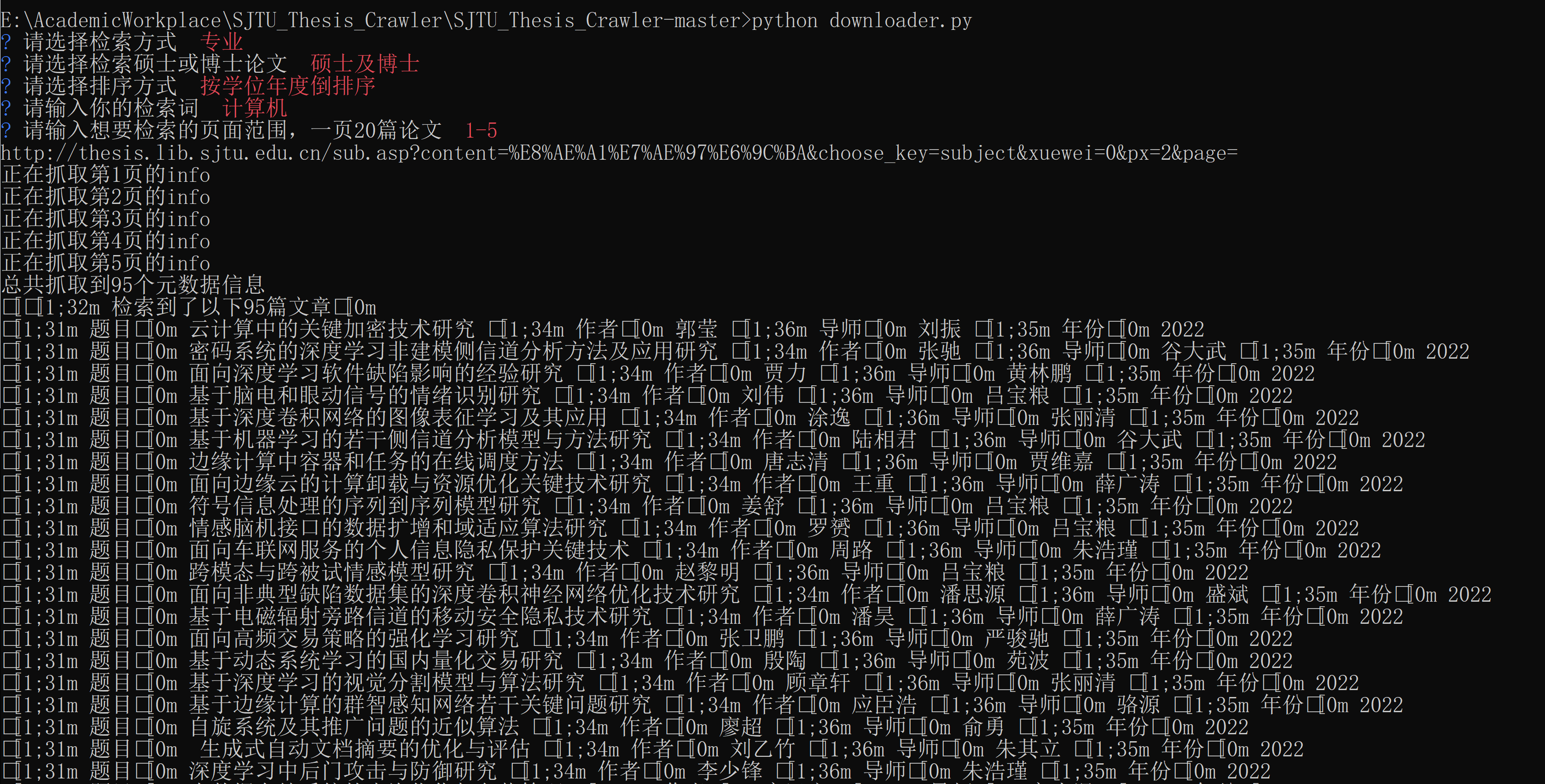1. Web场景
1. 自动配置
1、整合web场景
<dependency>
<groupId>org.springframework.boot</groupId>
<artifactId>spring-boot-starter-web</artifactId>
</dependency>2、引入了 autoconfigure功能(自动配置功能)
3、@EnableAutoConfiguration注解使用@Import(AutoConfigurationImportSelector.class)批量导入组件
4、加载 META-INF/spring/org.springframework.boot.autoconfigure.AutoConfiguration.imports 文件中配置的所有组件
5、所有自动配置类如下
org.springframework.boot.autoconfigure.web.client.RestTemplateAutoConfiguration
org.springframework.boot.autoconfigure.web.embedded.EmbeddedWebServerFactoryCustomizerAutoConfiguration
====以下是响应式web场景和现在的没关系======
org.springframework.boot.autoconfigure.web.reactive.HttpHandlerAutoConfiguration
org.springframework.boot.autoconfigure.web.reactive.ReactiveMultipartAutoConfiguration
org.springframework.boot.autoconfigure.web.reactive.ReactiveWebServerFactoryAutoConfiguration
org.springframework.boot.autoconfigure.web.reactive.WebFluxAutoConfiguration
org.springframework.boot.autoconfigure.web.reactive.WebSessionIdResolverAutoConfiguration
org.springframework.boot.autoconfigure.web.reactive.error.ErrorWebFluxAutoConfiguration
org.springframework.boot.autoconfigure.web.reactive.function.client.ClientHttpConnectorAutoConfiguration
org.springframework.boot.autoconfigure.web.reactive.function.client.WebClientAutoConfiguration
================以上没关系=================
org.springframework.boot.autoconfigure.web.servlet.DispatcherServletAutoConfiguration
org.springframework.boot.autoconfigure.web.servlet.ServletWebServerFactoryAutoConfiguration
org.springframework.boot.autoconfigure.web.servlet.error.ErrorMvcAutoConfiguration
org.springframework.boot.autoconfigure.web.servlet.HttpEncodingAutoConfiguration
org.springframework.boot.autoconfigure.web.servlet.MultipartAutoConfiguration
org.springframework.boot.autoconfigure.web.servlet.WebMvcAutoConfiguration6、绑定了配置文件的一堆配置项
- 1、SpringMVC的所有配置
spring.mvc - 2、Web场景通用配置
spring.web - 3、文件上传配置
spring.servlet.multipart - 4、服务器的配置
server: 比如:编码方式
2. 默认效果
默认配置:
- 包含了 ContentNegotiatingViewResolver 和 BeanNameViewResolver 组件,方便视图解析
- 默认的静态资源处理机制: 静态资源放在 static 文件夹下即可直接访问
- 自动注册了 Converter,GenericConverter,Formatter组件,适配常见数据类型转换和格式化需求
- 支持 HttpMessageConverters,可以方便返回json等数据类型
- 注册 MessageCodesResolver,方便国际化及错误消息处理
- 支持 静态 index.html
- 自动使用ConfigurableWebBindingInitializer,实现消息处理、数据绑定、类型转化、数据校验等功能
重要:
- 如果想保持 boot mvc 的默认配置,并且自定义更多的 mvc 配置,如:interceptors, formatters, view controllers 等。可以使用@Configuration注解添加一个 WebMvcConfigurer 类型的配置类,并不要标注 @EnableWebMvc
- 如果想保持 boot mvc 的默认配置,但要自定义核心组件实例,比如:RequestMappingHandlerMapping, RequestMappingHandlerAdapter, 或ExceptionHandlerExceptionResolver,给容器中放一个 WebMvcRegistrations 组件即可
- 如果想全面接管 Spring MVC,@Configuration 标注一个配置类,并加上 @EnableWebMvc注解,实现 WebMvcConfigurer 接口
2. 静态资源
1. 默认规则
1. 静态资源映射
静态资源映射规则在 WebMvcAutoConfiguration 中进行了定义:
- /webjars/** 的所有路径 资源都在 classpath:/META-INF/resources/webjars/
- /** 的所有路径 资源都在 classpath:/META-INF/resources/、classpath:/resources/、classpath:/static/、classpath:/public/
- 所有静态资源都定义了缓存规则。【浏览器访问过一次,就会缓存一段时间】,但此功能参数无默认值
1.period: 缓存间隔。 默认 0S;
2.cacheControl:缓存控制。 默认无;
3.useLastModified:是否使用lastModified头。 默认 false;
2. 静态资源缓存
如前面所述
- 所有静态资源都定义了缓存规则。【浏览器访问过一次,就会缓存一段时间】,但此功能参数无默认值
-
- period: 缓存间隔。 默认 0S;
- cacheControl:缓存控制。 默认无;
- useLastModified:是否使用lastModified头。 默认 false;
3. 欢迎页
欢迎页规则在 WebMvcAutoConfiguration 中进行了定义:
- 在静态资源目录下找 index.html
- 没有就在 templates下找index模板页
4. Favicon
- 在静态资源目录下找 favicon.ico
5. 缓存实验
server.port=9000
#1、spring.web:
# 1.配置国际化的区域信息
# 2.静态资源策略(开启、处理链、缓存)
#开启静态资源映射规则
spring.web.resources.add-mappings=true
#设置缓存
#spring.web.resources.cache.period=3600
##缓存详细合并项控制,覆盖period配置:
## 浏览器第一次请求服务器,服务器告诉浏览器此资源缓存7200秒,7200秒以内的所有此资源访问不用发给服务器请求,7200秒以后发请求给服务器
spring.web.resources.cache.cachecontrol.max-age=7200
#使用资源 last-modified 时间,来对比服务器和浏览器的资源是否相同没有变化。相同返回 304
spring.web.resources.cache.use-last-modified=true2. 自定义静态资源规则
自定义静态资源路径、自定义缓存规则
1. 配置方式
spring.mvc: 静态资源访问前缀路径
spring.web:
- 静态资源目录
- 静态资源缓存策略
#1、spring.web:
# 1.配置国际化的区域信息
# 2.静态资源策略(开启、处理链、缓存)
#开启静态资源映射规则
spring.web.resources.add-mappings=true
#设置缓存
spring.web.resources.cache.period=3600
##缓存详细合并项控制,覆盖period配置:
## 浏览器第一次请求服务器,服务器告诉浏览器此资源缓存7200秒,7200秒以内的所有此资源访问不用发给服务器请求,7200秒以后发请求给服务器
spring.web.resources.cache.cachecontrol.max-age=7200
## 共享缓存
spring.web.resources.cache.cachecontrol.cache-public=true
#使用资源 last-modified 时间,来对比服务器和浏览器的资源是否相同没有变化。相同返回 304
spring.web.resources.cache.use-last-modified=true
#自定义静态资源文件夹位置
spring.web.resources.static-locations=classpath:/a/,classpath:/b/,classpath:/static/
#2、 spring.mvc
## 2.1. 自定义webjars路径前缀
spring.mvc.webjars-path-pattern=/wj/**
## 2.2. 静态资源访问路径前缀
spring.mvc.static-path-pattern=/static/**2. 代码方式
- 容器中只要有一个 WebMvcConfigurer 组件。配置的底层行为都会生效
- @EnableWebMvc //禁用boot的默认配置
//@EnableWebMvc //禁用boot的默认配置
@Configuration //这是一个配置类
public class MyConfig implements WebMvcConfigurer {
@Override
public void addResourceHandlers(ResourceHandlerRegistry registry) {
//保留以前规则
//自己写新的规则。
registry.addResourceHandler("/static/**")
.addResourceLocations("classpath:/a/","classpath:/b/")
.setCacheControl(CacheControl.maxAge(1180, TimeUnit.SECONDS));
}
}@Configuration //这是一个配置类,给容器中放一个 WebMvcConfigurer 组件,就能自定义底层
public class MyConfig /*implements WebMvcConfigurer*/ {
@Bean
public WebMvcConfigurer webMvcConfigurer(){
return new WebMvcConfigurer() {
@Override
public void addResourceHandlers(ResourceHandlerRegistry registry) {
registry.addResourceHandler("/static/**")
.addResourceLocations("classpath:/a/", "classpath:/b/")
.setCacheControl(CacheControl.maxAge(1180, TimeUnit.SECONDS));
}
};
}
}原因?为什么容器中放一个WebMvcConfigurer就能配置底层行为?
1.WebMvcAutoConfiguration是一个自动配置类,它里面有一个EnableWebMvcConfiguration
2. EnableWebMvcConfiguration继承于DelegatingWebMvcConfiguration,这两个都生效
3.DelegatingWebMvcConfiguration利用DI把容器中所有的WebConfigurer注入进来
4.别人调用DelegatingWebMvcConfiguration的方法配置底层原则,而他调用所有的WebConfigurer的配置底层方法
3. 路径匹配
Spring5.3 之后加入了更多的请求路径匹配的实现策略;
以前只支持 AntPathMatcher 策略, 现在提供了 PathPatternParser 策略。并且可以让我们指定到底使用那种策略。
1. Ant风格路径用法
Ant 风格的路径模式语法具有以下规则:
- *:表示任意数量的字符。
- ?:表示任意一个字符。
- **:表示任意数量的目录。
- {}:表示一个命名的模式占位符。
- []:表示字符集合,例如[a-z]表示小写字母。
例如:
- *.html 匹配任意名称,扩展名为.html的文件。
- /folder1/*/*.java 匹配在folder1目录下的任意两级目录下的.java文件。
- /folder2/**/*.jsp 匹配在folder2目录下任意目录深度的.jsp文件。
- /{type}/{id}.html 匹配任意文件名为{id}.html,在任意命名的{type}目录下的文件。
注意:Ant 风格的路径模式语法中的特殊字符需要转义,如:
- 要匹配文件路径中的星号,则需要转义为\\*。
- 要匹配文件路径中的问号,则需要转义为\\?。
2. 模式切换
AntPathMatcher 与 PathPatternParser
- PathPatternParser 在 jmh 基准测试下,有 6~8 倍吞吐量提升,降低 30%~40%空间分配率
- PathPatternParser 兼容 AntPathMatcher语法,并支持更多类型的路径模式
- PathPatternParser "**" 多段匹配的支持仅允许在模式末尾使用
@GetMapping("/a*/b?/{p1:[a-f]+}")
public String hello(HttpServletRequest request,
@PathVariable("p1") String path) {
log.info("路径变量p1: {}", path);
//获取请求路径
String uri = request.getRequestURI();
return uri;
}总结:
- 使用默认的路径匹配规则,是由 PathPatternParser 提供的
- 如果路径中间需要有 **,替换成ant风格路径
# 改变路径匹配策略:
# ant_path_matcher 老版策略;
# path_pattern_parser 新版策略;
spring.mvc.pathmatch.matching-strategy=ant_path_matcher4. 内容协商
一套系统适配多端数据返回

1. 多端内容适配
1. 默认规则
- SpringBoot 多端内容适配。
基于请求头内容协商:(默认开启)
客户端向服务端发送请求,携带HTTP标准的Accept请求头。
Accept:application/json、text/xml、text/yaml
服务端根据客户端请求头期望的数据类型进行动态返回
基于请求参数内容协商:(需要开启)
发送请求 GET /projects/spring-boot?format=json
发送请求 GET /projects/spring-boot?format=xml,优先返回 xml 类型数据
根据参数协商,优先返回 json 类型数据【需要开启参数匹配设置】
匹配到 @GetMapping("/projects/spring-boot")
2. 效果演示
请求同一个接口,可以返回json和xml不同格式数据
- 引入支持写出xml内容依赖
<dependency>
<groupId>com.fasterxml.jackson.dataformat</groupId>
<artifactId>jackson-dataformat-xml</artifactId>
</dependency>- 标注注解
- 开启基于请求参数的内容协商
# 开启基于请求参数的内容协商功能。 默认参数名:format。 默认此功能不开启
spring.mvc.contentnegotiation.favor-parameter=true
# 指定内容协商时使用的参数名。默认是 format
spring.mvc.contentnegotiation.parameter-name=type- 效果
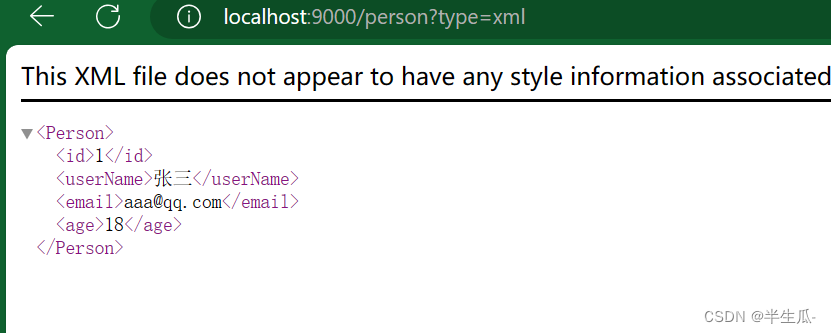
3. 配置协商规则与支持类型
- 修改内容协商方式
#使用参数进行内容协商
spring.mvc.contentnegotiation.favor-parameter=true
#自定义参数名,默认为format
spring.mvc.contentnegotiation.parameter-name=myparam - 大多数 MediaType 都是开箱即用的。也可以自定义内容类型,如:
spring.mvc.contentnegotiation.media-types.yaml=text/yaml2. 自定义内容返回
1. 增加yaml返回支持
导入依赖
<dependency>
<groupId>com.fasterxml.jackson.dataformat</groupId>
<artifactId>jackson-dataformat-yaml</artifactId>
</dependency>把对象写出成YAML
public static void main(String[] args) throws JsonProcessingException {
Person person = new Person();
person.setId(1L);
person.setUserName("张三");
person.setEmail("aaa@qq.com");
person.setAge(18);
YAMLFactory factory = new YAMLFactory().disable(YAMLGenerator.Feature.WRITE_DOC_START_MARKER);
ObjectMapper mapper = new ObjectMapper(factory);
String s = mapper.writeValueAsString(person);
System.out.println(s);
}编写配置
#新增一种媒体类型
spring.mvc.contentnegotiation.media-types.yaml=text/yaml增加HttpMessageConverter组件,专门负责把对象写出为yaml格式
@Bean
public WebMvcConfigurer webMvcConfigurer(){
return new WebMvcConfigurer() {
@Override //配置一个能把对象转为yaml的messageConverter
public void configureMessageConverters(List<HttpMessageConverter<?>> converters) {
converters.add(new MyYamlHttpMessageConverter());
}
};
}2. 思考:如何增加其他
- 配置媒体类型支持:
-
spring.mvc.contentnegotiation.media-types.yaml=text/yaml
- 编写对应的
HttpMessageConverter,要告诉Boot这个支持的媒体类型
-
- 按照3的示例
- 把MessageConverter组件加入到底层
-
- 容器中放一个`
WebMvcConfigurer` 组件,并配置底层的MessageConverter
- 容器中放一个`
3. HttpMessageConverter的示例写法
public class MyYamlHttpMessageConverter extends AbstractHttpMessageConverter<Object> {
private ObjectMapper objectMapper = null; //把对象转成yaml
public MyYamlHttpMessageConverter(){
//告诉SpringBoot这个MessageConverter支持哪种媒体类型 //媒体类型
super(new MediaType("text", "yaml", Charset.forName("UTF-8")));
YAMLFactory factory = new YAMLFactory()
.disable(YAMLGenerator.Feature.WRITE_DOC_START_MARKER);
this.objectMapper = new ObjectMapper(factory);
}
@Override
protected boolean supports(Class<?> clazz) {
//只要是对象类型,不是基本类型
return true;
}
@Override //@RequestBody
protected Object readInternal(Class<?> clazz, HttpInputMessage inputMessage) throws IOException, HttpMessageNotReadableException {
return null;
}
@Override //@ResponseBody 把对象怎么写出去
protected void writeInternal(Object methodReturnValue, HttpOutputMessage outputMessage) throws IOException, HttpMessageNotWritableException {
//try-with写法,自动关流
try(OutputStream os = outputMessage.getBody()){
this.objectMapper.writeValue(os,methodReturnValue);
}
}
}3. 内容协商原理-HttpMessageConverter
HttpMessageConverter怎么工作?合适工作?- 定制
HttpMessageConverter来实现多端内容协商 - 编写
WebMvcConfigurer提供的configureMessageConverters底层,修改底层的MessageConverter
1. @ResponseBody由HttpMessageConverter处理
标注了@ResponseBody的返回值 将会由支持它的 HttpMessageConverter写给浏览器
- 如果controller方法的返回值标注了
@ResponseBody注解
-
- 请求进来先来到
DispatcherServlet的doDispatch()进行处理 - 找到一个
HandlerAdapter适配器。利用适配器执行目标方法 RequestMappingHandlerAdapter来执行,调用invokeHandlerMethod()来执行目标方法- 目标方法执行之前,准备好两个东西
- 请求进来先来到
-
-
HandlerMethodArgumentResolver:参数解析器,确定目标方法每个参数值HandlerMethodReturnValueHandler:返回值处理器,确定目标方法的返回值改怎么处理
-
-
RequestMappingHandlerAdapter里面的invokeAndHandle()真正执行目标方法- 目标方法执行完成,会返回返回值对象
- 找到一个合适的返回值处理器
HandlerMethodReturnValueHandler - 最终找到
RequestResponseBodyMethodProcessor能处理 标注了@ResponseBody注解的方法 RequestResponseBodyMethodProcessor调用writeWithMessageConverters,利用MessageConverter把返回值写出去
上面解释:@ResponseBody由HttpMessageConverter处理
HttpMessageConverter会先进行内容协商
-
- 遍历所有的
MessageConverter看谁支持这种内容类型的数据 - 默认
MessageConverter有以下 -
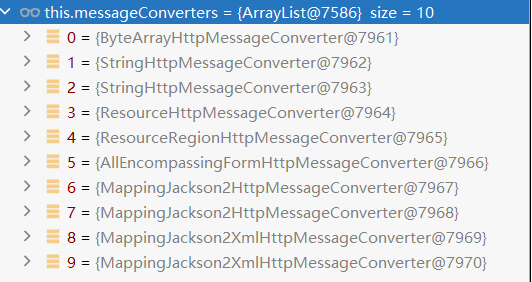
- 最终因为要
json所以MappingJackson2HttpMessageConverter支持写出json - jackson用
ObjectMapper把对象写出去
- 遍历所有的
2. WebMvcAutoConfiguration提供几种默认HttpMessageConverters
EnableWebMvcConfiguration通过addDefaultHttpMessageConverters添加了默认的MessageConverter;如下:
-
ByteArrayHttpMessageConverter: 支持字节数据读写StringHttpMessageConverter: 支持字符串读写ResourceHttpMessageConverter:支持资源读写ResourceRegionHttpMessageConverter: 支持分区资源写出AllEncompassingFormHttpMessageConverter:支持表单xml/json读写MappingJackson2HttpMessageConverter: 支持请求响应体Json读写
默认8个:
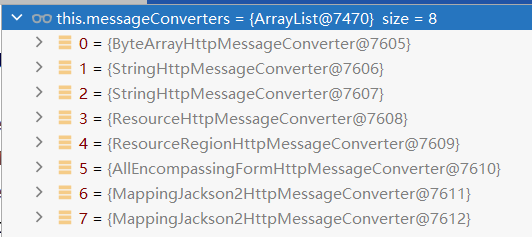
系统提供默认的MessageConverter 功能有限,仅用于json或者普通返回数据。额外增加新的内容协商功能,必须增加新的HttpMessageConverter
5. 模板引擎
- 由于 SpringBoot 使用了嵌入式 Servlet 容器。所以 JSP 默认是不能使用的。
- 如果需要服务端页面渲染,优先考虑使用 模板引擎。
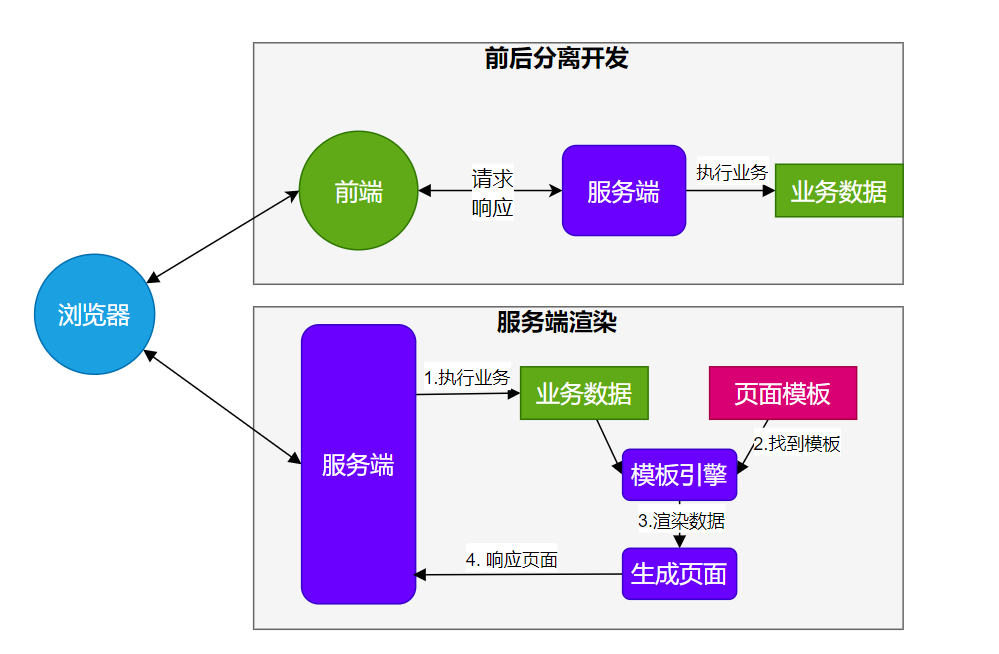
模板引擎页面默认放在 src/main/resources/templates
SpringBoot 包含以下模板引擎的自动配置
- FreeMarker
- Groovy
- Thymeleaf
- Mustache
Thymeleaf官网:Thymeleaf
<!DOCTYPE html>
<html xmlns:th="http://www.thymeleaf.org">
<head>
<title>Good Thymes Virtual Grocery</title>
<meta http-equiv="Content-Type" content="text/html; charset=UTF-8" />
<link rel="stylesheet" type="text/css" media="all" th:href="@{/css/gtvg.css}" />
</head>
<body>
<p th:text="#{home.welcome}">Welcome to our grocery store!</p>
</body
</html>1. Thymeleaf整合
<dependency>
<groupId>org.springframework.boot</groupId>
<artifactId>spring-boot-starter-thymeleaf</artifactId>
</dependency>自动配置原理
- 开启了 org.springframework.boot.autoconfigure.thymeleaf.ThymeleafAutoConfiguration 自动配置
- 属性绑定在 ThymeleafProperties 中,对应配置文件 spring.thymeleaf 内容
- 所有的模板页面默认在
classpath:/templates文件夹下 - 默认效果
所有的模板页面在classpath:/templates/下面找
找后缀名为.html的页面
2. 基础语法
1. 核心用法
th:xxx:动态渲染指定的 html 标签属性值、或者th指令(遍历、判断等)
th:text:标签体内文本值渲染
th:utext:不会转义,显示为html原本的样子。th:属性:标签指定属性渲染th:attr:标签任意属性渲染th:ifth:each...:其他th指令- 例如:
<img th:src="${imgUrl}" src="1.jpg" style="width: 300px;">
<br>
th:attr:任意属性指定
<img src="/static/1.jpg" style="width: 300px;" th:attr="src=@{/static/1.jpg},style=${style}">
@{}专门用来取各种路径
<img src="/static/1.jpg" style="width: 300px;" th:src="@{/static/1.jpg}">表达式:用来动态取值
${}:变量取值;使用model共享给页面的值都直接用${}@{}:url路径;#{}:国际化消息~{}:片段引用*{}:变量选择:需要配合th:object绑定对象
系统工具&内置对象:详细文档
param:请求参数对象session:session对象application:application对象#execInfo:模板执行信息#messages:国际化消息#uris:uri/url工具#conversions:类型转换工具#dates:日期工具,是java.util.Date对象的工具类#calendars:类似#dates,只不过是java.util.Calendar对象的工具类#temporals: JDK8+java.timeAPI 工具类#numbers:数字操作工具#strings:字符串操作#objects:对象操作#bools:bool操作#arrays:array工具#lists:list工具#sets:set工具#maps:map工具#aggregates:集合聚合工具(sum、avg)#ids:id生成工具
2. 语法示例
表达式:
- 变量取值:${...}
- url 取值:@{...}
- 国际化消息:#{...}
- 变量选择:*{...}
- 片段引用: ~{...}
常见:
- 文本: 'one text','another one!',...
- 数字: 0,34,3.0,12.3,...
- 布尔:true、false
- null: null
- 变量名: one,sometext,main...
文本操作:
- 拼串: +
- 文本替换:| The name is ${name} |
布尔操作:
- 二进制运算: and,or
- 取反:!,not
比较运算:
- 比较:>,<,<=,>=(gt,lt,ge,le)
- 等值运算:==,!=(eq,ne)
条件运算:
- if-then: (if)?(then)
- if-then-else: (if)?(then):(else)
- default: (value)?:(defaultValue)
特殊语法:
- 无操作:_
所有以上都可以嵌套组合
'User is of type ' + (${user.isAdmin()} ? 'Administrator' : (${user.type} ?: 'Unknown'))3. 属性设置
- th:href="@{/product/list}"
- th:attr="class=${active}"
- th:attr="src=@{/images/gtvglogo.png},title=${logo},alt=#{logo}"
- th:checked="${user.active}"
<p th:text="${content}">原内容</p>
<a th:href="${url}">登录</a>
<img src="../../images/gtvglogo.png"
th:attr="src=@{/images/gtvglogo.png},title=#{logo},alt=#{logo}" />4. 遍历
语法: th:each="元素名,迭代状态 : ${集合}"
<tr th:each="prod : ${prods}">
<td th:text="${prod.name}">Onions</td>
<td th:text="${prod.price}">2.41</td>
<td th:text="${prod.inStock}? #{true} : #{false}">yes</td>
</tr>
<tr th:each="prod,iterStat : ${prods}" th:class="${iterStat.odd}? 'odd'">
<td th:text="${prod.name}">Onions</td>
<td th:text="${prod.price}">2.41</td>
<td th:text="${prod.inStock}? #{true} : #{false}">yes</td>
</tr>iterStat 有以下属性:
- index:当前遍历元素的索引,从0开始
- count:当前遍历元素的索引,从1开始
- size:需要遍历元素的总数量
- current:当前正在遍历的元素对象
- even/odd:是否偶数/奇数行
- first:是否第一个元素
- last:是否最后一个元素
5. 判断
th:if
<a
href="comments.html"
th:href="@{/product/comments(prodId=${prod.id})}"
th:if="${not #lists.isEmpty(prod.comments)}"
>view</ath:switch
<div th:switch="${user.role}">
<p th:case="'admin'">User is an administrator</p>
<p th:case="#{roles.manager}">User is a manager</p>
<p th:case="*">User is some other thing</p>
</div>6. 属性优先级
- 片段
- 遍历
- 判断
<ul>
<li th:each="item : ${items}" th:text="${item.description}">Item description here...</li>
</ul>| Order | Feature | Attributes |
| 1 | 片段包含 | th:insert th:replace |
| 2 | 遍历 | th:each |
| 3 | 判断 | th:if th:unless th:switch th:case |
| 4 | 定义本地变量 | th:object th:with |
| 5 | 通用方式属性修改 | th:attr th:attrprepend th:attrappend |
| 6 | 指定属性修改 | th:value th:href th:src ... |
| 7 | 文本值 | th:text th:utext |
| 8 | 片段指定 | th:fragment |
| 9 | 片段移除 | th:remove |
7. 行内写法
[[...]] or [(...)]
<p>Hello, [[${session.user.name}]]!</p>8. 变量选择
<div th:object="${session.user}">
<p>Name: <span th:text="*{firstName}">Sebastian</span>.</p>
<p>Surname: <span th:text="*{lastName}">Pepper</span>.</p>
<p>Nationality: <span th:text="*{nationality}">Saturn</span>.</p>
</div>等同于
<div>
<p>Name: <span th:text="${session.user.firstName}">Sebastian</span>.</p>
<p>Surname: <span th:text="${session.user.lastName}">Pepper</span>.</p>
<p>Nationality: <span th:text="${session.user.nationality}">Saturn</span>.</p>
</div9. 模板布局
- 定义模板:
th:fragment - 引用模板:
~{templatename::selector} - 插入模板:
th:insert、th:replace
<footer th:fragment="copy">© 2011 The Good Thymes Virtual Grocery</footer>
<body>
<div th:insert="~{footer :: copy}"></div>
<div th:replace="~{footer :: copy}"></div>
</body>
<body>
结果:
<body>
<div>
<footer>© 2011 The Good Thymes Virtual Grocery</footer>
</div>
<footer>© 2011 The Good Thymes Virtual Grocery</footer>
</body>
</body>实例:
<!DOCTYPE html>
<html lang="en" xmlns:th="http://www.thymeleaf.org">>>
<head>
<meta charset="UTF-8">
<title>首页</title>
<link href="https://cdn.jsdelivr.net/npm/bootstrap@5.3.2/dist/css/bootstrap.min.css" rel="stylesheet" integrity="sha384-T3c6CoIi6uLrA9TneNEoa7RxnatzjcDSCmG1MXxSR1GAsXEV/Dwwykc2MPK8M2HN" crossorigin="anonymous">
</head>
<body>
<!--导航区 使用公共部分替换-->
<div th:replace="~{common :: myheader}"></div>
<div class="container">
<a th:href="@{/list}">展示列表1278</a>
</div>
<script src="https://cdn.jsdelivr.net/npm/bootstrap@5.3.2/dist/js/bootstrap.bundle.min.js" integrity="sha384-C6RzsynM9kWDrMNeT87bh95OGNyZPhcTNXj1NW7RuBCsyN/o0jlpcV8Qyq46cDfL" crossorigin="anonymous"></script>
</body>
</html>10. devtools 热启动功能
<dependency>
<groupId>org.springframework.boot</groupId>
<artifactId>spring-boot-devtools</artifactId>
</dependency>修改页面后;ctrl+F9刷新效果;
java代码的修改,如果devtools热启动了,可能会引起一些bug,难以排查
6. 国际化
国际化的自动配置参照MessageSourceAutoConfiguration
实现步骤:
- Spring Boot 在类路径根下查找messages资源绑定文件。文件名为:messages.properties
- 多语言可以定义多个消息文件,命名为
messages_区域代码.properties。如:
-
messages.properties:默认messages_zh_CN.properties:中文环境messages_en_US.properties:英语环境
- 在程序中可以自动注入
MessageSource组件,获取国际化的配置项值 - 在页面中可以使用表达式
#{}获取国际化的配置项值
@Autowired //国际化取消息用的组件
MessageSource messageSource;
@GetMapping("/haha")
public String haha(HttpServletRequest request){
Locale locale = request.getLocale();
//利用代码的方式获取国际化配置文件中指定的配置项的值
String login = messageSource.getMessage("login", null, locale);
return login;
}
7. 错误处理
1. 默认机制
错误处理的自动配置都在ErrorMvcAutoConfiguration中,两大核心机制:
- 1. SpringBoot 会自适应处理错误,响应页面或JSON数据
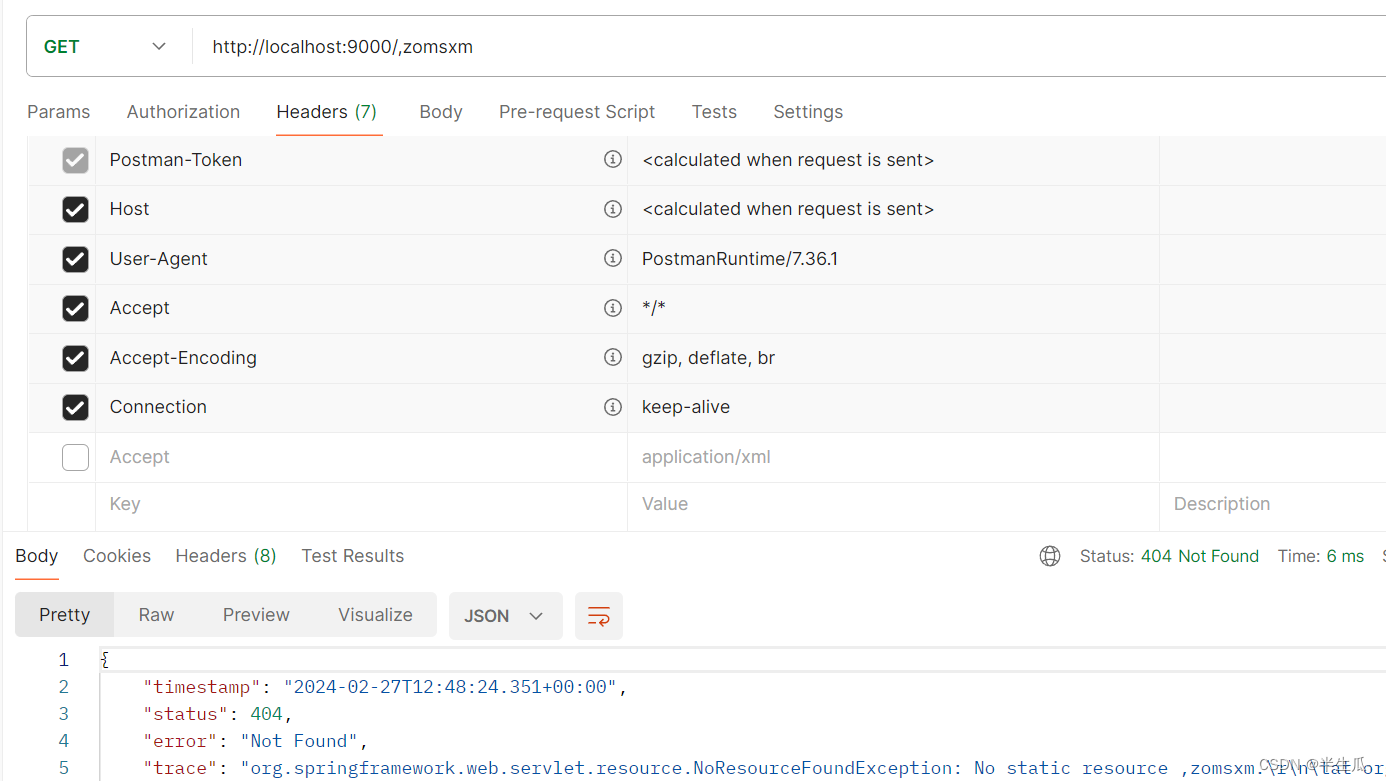
- 2. SpringMVC的错误处理机制依然保留,MVC处理不了,才会交给boot进行处理
业务发生错误--->@EceptionHandler机制是否能处理--->@ResponseStatus机制能否处理--->SpringMVC定义的默认错误响应是否能处理---都不能时请求转发/error
能处理则响应错误处理结果
- 发生错误以后,转发给/error路径,SpringBoot在底层写好一个 BasicErrorController的组件,专门处理这个请求
@RequestMapping(produces = MediaType.TEXT_HTML_VALUE) //返回HTML
public ModelAndView errorHtml(HttpServletRequest request, HttpServletResponse response) {
HttpStatus status = getStatus(request);
Map<String, Object> model = Collections
.unmodifiableMap(getErrorAttributes(request, getErrorAttributeOptions(request, MediaType.TEXT_HTML)));
response.setStatus(status.value());
ModelAndView modelAndView = resolveErrorView(request, response, status, model);
return (modelAndView != null) ? modelAndView : new ModelAndView("error", model);
}
@RequestMapping //返回 ResponseEntity, JSON
public ResponseEntity<Map<String, Object>> error(HttpServletRequest request) {
HttpStatus status = getStatus(request);
if (status == HttpStatus.NO_CONTENT) {
return new ResponseEntity<>(status);
}
Map<String, Object> body = getErrorAttributes(request, getErrorAttributeOptions(request, MediaType.ALL));
return new ResponseEntity<>(body, status);
}- 错误页面是这么解析到的
//1、解析错误的自定义视图地址
ModelAndView modelAndView = resolveErrorView(request, response, status, model);
//2、如果解析不到错误页面的地址,默认的错误页就是 error
return (modelAndView != null) ? modelAndView : new ModelAndView("error", model);容器中专门有一个错误视图解析器
@Bean
@ConditionalOnBean(DispatcherServlet.class)
@ConditionalOnMissingBean(ErrorViewResolver.class)
DefaultErrorViewResolver conventionErrorViewResolver() {
return new DefaultErrorViewResolver(this.applicationContext, this.resources);
}SpringBoot解析自定义错误页的默认规则
@Override
public ModelAndView resolveErrorView(HttpServletRequest request, HttpStatus status, Map<String, Object> model) {
ModelAndView modelAndView = resolve(String.valueOf(status.value()), model);
if (modelAndView == null && SERIES_VIEWS.containsKey(status.series())) {
modelAndView = resolve(SERIES_VIEWS.get(status.series()), model);
}
return modelAndView;
}
private ModelAndView resolve(String viewName, Map<String, Object> model) {
String errorViewName = "error/" + viewName;
TemplateAvailabilityProvider provider = this.templateAvailabilityProviders.getProvider(errorViewName,
this.applicationContext);
if (provider != null) {
return new ModelAndView(errorViewName, model);
}
return resolveResource(errorViewName, model);
}
private ModelAndView resolveResource(String viewName, Map<String, Object> model) {
for (String location : this.resources.getStaticLocations()) {
try {
Resource resource = this.applicationContext.getResource(location);
resource = resource.createRelative(viewName + ".html");
if (resource.exists()) {
return new ModelAndView(new HtmlResourceView(resource), model);
}
}
catch (Exception ex) {
}
}
return null;
}容器中有一个默认的名为 error 的 view; 提供了默认白页功能
@Bean(name = "error")
@ConditionalOnMissingBean(name = "error")
public View defaultErrorView() {
return this.defaultErrorView;
}封装了JSON格式的错误信息
@Bean
@ConditionalOnMissingBean(value = ErrorAttributes.class, search = SearchStrategy.CURRENT)
public DefaultErrorAttributes errorAttributes() {
return new DefaultErrorAttributes();
}规则:
解析一个错误页
- 如果发生了500、404、503、403 这些错误
- 如果有模板引擎,默认在
classpath:/templates/error/精确码.html- 如果没有模板引擎,在静态资源文件夹下找
精确码.html- 如果匹配不到
精确码.html这些精确的错误页,就去找5xx.html,4xx.html模糊匹配- 如果有模板引擎,默认在
classpath:/templates/error/5xx.html- 如果没有模板引擎,在静态资源文件夹下找
5xx.html- 如果模板引擎路径
templates下有error.html页面,就直接渲染
2. 自定义错误响应
1. 自定义json响应
使用@ControllerAdvice + @ExceptionHandler 进行统一异常处理
2. 自定义页面响应
根据boot的错误页面规则,自定义页面模板
3. 最佳实战
- 前后分离
- 后台发生的所有错误,
@ControllerAdvice + @ExceptionHandler进行统一异常处理。
- 服务端页面渲染
- 不可预知的一些,HTTP码表示的服务器或客户端错误
- 给
classpath:/templates/error/下面,放常用精确的错误码页面。500.html,404.html- 给
classpath:/templates/error/下面,放通用模糊匹配的错误码页面。5xx.html,4xx.html
- 发生业务错误
- 核心业务,每一种错误,都应该代码控制,跳转到自己定制的错误页。
- 通用业务,
classpath:/templates/error.html页面,显示错误信息。
页面,JSON,可用的Model数据如下

8. 嵌入式容器
Servlet容器:管理、运行Servlet组件(Servlet、Filter、Listener)的环境,一般指服务器
1. 自动配置原理
- SpringBoot 默认嵌入Tomcat作为Servlet容器。
- 自动配置类是
ServletWebServerFactoryAutoConfiguration,EmbeddedWebServerFactoryCustomizerAutoConfiguration - 自动配置类开始分析功能。`xxxxAutoConfiguration`
@AutoConfiguration
@AutoConfigureOrder(Ordered.HIGHEST_PRECEDENCE)
@ConditionalOnClass(ServletRequest.class)
@ConditionalOnWebApplication(type = Type.SERVLET)
@EnableConfigurationProperties(ServerProperties.class)
@Import({ ServletWebServerFactoryAutoConfiguration.BeanPostProcessorsRegistrar.class,
ServletWebServerFactoryConfiguration.EmbeddedTomcat.class,
ServletWebServerFactoryConfiguration.EmbeddedJetty.class,
ServletWebServerFactoryConfiguration.EmbeddedUndertow.class })
public class ServletWebServerFactoryAutoConfiguration {
}
ServletWebServerFactoryAutoConfiguration自动配置了嵌入式容器场景- 绑定了
ServerProperties配置类,所有和服务器有关的配置server
3.ServletWebServerFactoryAutoConfiguration导入了 嵌入式的三大服务器Tomcat、Jetty、Undertow
- 导入
Tomcat、Jetty、Undertow都有条件注解。系统中有这个类才行(也就是导了包- 默认
Tomcat配置生效。给容器中放 TomcatServletWebServerFactory- 都给容器中
ServletWebServerFactory放了一个 web服务器工厂(造web服务器的)- web服务器工厂 都有一个功能,
getWebServer获取web服务器- TomcatServletWebServerFactory 创建了 tomcat。
4.ServletWebServerFactory 什么时候会创建 webServer出来。
5.ServletWebServerApplicationContextioc容器,启动的时候会调用创建web服务器6.Spring容器刷新(启动)的时候,会预留一个时机,刷新子容器。
onRefresh()7.refresh() 容器刷新 十二大步的刷新子容器会调用
onRefresh();
@Override
protected void onRefresh() {
super.onRefresh();
try {
createWebServer();
}
catch (Throwable ex) {
throw new ApplicationContextException("Unable to start web server", ex);
}
}Web场景的Spring容器启动,在onRefresh的时候,会调用创建web服务器的方法。
Web服务器的创建是通过WebServerFactory搞定的。容器中又会根据导了什么包条件注解,启动相关的 服务器配置,默认EmbeddedTomcat会给容器中放一个 TomcatServletWebServerFactory,导致项目启动,自动创建出Tomcat。
2. 自定义
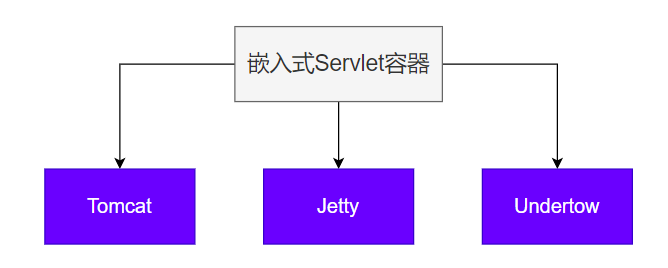
切换服务器;
<properties>
<servlet-api.version>3.1.0</servlet-api.version>
</properties>
<dependency>
<groupId>org.springframework.boot</groupId>
<artifactId>spring-boot-starter-web</artifactId>
<exclusions>
<!-- Exclude the Tomcat dependency -->
<exclusion>
<groupId>org.springframework.boot</groupId>
<artifactId>spring-boot-starter-tomcat</artifactId>
</exclusion>
</exclusions>
</dependency>
<!-- Use Jetty instead -->
<dependency>
<groupId>org.springframework.boot</groupId>
<artifactId>spring-boot-starter-jetty</artifactId>
</dependency>3. 最佳实践
用法:
- 修改
server下的相关配置就可以修改服务器参数 - 通过给容器中放一个
ServletWebServerFactory,来禁用掉SpringBoot默认放的服务器工厂,实现自定义嵌入任意服务器。
9. 全面接管SpringMVC
- SpringBoot 默认配置好了 SpringMVC 的所有常用特性。
- 如果我们需要全面接管SpringMVC的所有配置并禁用默认配置,仅需要编写一个
WebMvcConfigurer配置类,并标注@EnableWebMvc即可
全手动模式
@EnableWebMvc: 禁用默认配置WebMvcConfigurer组件:定义MVC的底层行为
1. WebMvcAutoConfiguration 到底自动配置了哪些规则
SpringMVC自动配置场景给我们配置了如下所有默认行为
WebMvcAutoConfigurationweb场景的自动配置类
-
- 支持RESTful的filter:HiddenHttpMethodFilter
- 支持非POST请求,请求体携带数据:FormContentFilter
- 导入
EnableWebMvcConfiguration:
-
-
RequestMappingHandlerAdapterWelcomePageHandlerMapping: 欢迎页功能支持(模板引擎目录、静态资源目录放index.html),项目访问/ 就默认展示这个页面.RequestMappingHandlerMapping:找每个请求由谁处理的映射关系ExceptionHandlerExceptionResolver:默认的异常解析器LocaleResolver:国际化解析器ThemeResolver:主题解析器FlashMapManager:临时数据共享FormattingConversionService: 数据格式化 、类型转化Validator: 数据校验JSR303提供的数据校验功能WebBindingInitializer:请求参数的封装与绑定ContentNegotiationManager:内容协商管理器
-
-
WebMvcAutoConfigurationAdapter配置生效,它是一个WebMvcConfigurer,定义mvc底层组件
-
-
- 定义好
WebMvcConfigurer底层组件默认功能;所有功能详见列表 - 视图解析器:
InternalResourceViewResolver - 视图解析器:
BeanNameViewResolver,视图名(controller方法的返回值字符串)就是组件名 - 内容协商解析器:
ContentNegotiatingViewResolver - 请求上下文过滤器:
RequestContextFilter: 任意位置直接获取当前请求 - 静态资源链规则
ProblemDetailsExceptionHandler:错误详情
- 定义好
-
-
-
-
- SpringMVC内部场景异常被它捕获:
-
-
-
- 定义了MVC默认的底层行为:
WebMvcConfigurer
- 定义了MVC默认的底层行为:
2. @EnableWebMvc 禁用默认行为
@EnableWebMvc给容器中导入DelegatingWebMvcConfiguration组件,
他是 WebMvcConfigurationSupport
WebMvcAutoConfiguration有一个核心的条件注解,@ConditionalOnMissingBean(WebMvcConfigurationSupport.class),容器中没有WebMvcConfigurationSupport,WebMvcAutoConfiguration才生效.- @EnableWebMvc 导入
WebMvcConfigurationSupport导致WebMvcAutoConfiguration失效。导致禁用了默认行为
- @EnableWebMVC 禁用了 Mvc的自动配置
- WebMvcConfigurer 定义SpringMVC底层组件的功能类
2. WebMvcConfigurer 功能
定义扩展SpringMVC底层功能
| 提供方法 | 核心参数 | 功能 | 默认 |
| addFormatters | FormatterRegistry | 格式化器:支持属性上@NumberFormat和@DatetimeFormat的数据类型转换 | GenericConversionService |
| getValidator | 无 | 数据校验:校验 Controller 上使用@Valid标注的参数合法性。需要导入starter-validator | 无 |
| addInterceptors | InterceptorRegistry | 拦截器:拦截收到的所有请求 | 无 |
| configureContentNegotiation | ContentNegotiationConfigurer | 内容协商:支持多种数据格式返回。需要配合支持这种类型的HttpMessageConverter | 支持 json |
| configureMessageConverters | List<HttpMessageConverter<?>> | 消息转换器:标注@ResponseBody的返回值会利用MessageConverter直接写出去 | 8 个,支持byte,string,multipart,resource,json |
| addViewControllers | ViewControllerRegistry | 视图映射:直接将请求路径与物理视图映射。用于无 java 业务逻辑的直接视图页渲染 | 无 |
| configureViewResolvers | ViewResolverRegistry | 视图解析器:逻辑视图转为物理视图 | ViewResolverComposite |
| addResourceHandlers | ResourceHandlerRegistry | 静态资源处理:静态资源路径映射、缓存控制 | ResourceHandlerRegistry |
| configureDefaultServletHandling | DefaultServletHandlerConfigurer | 默认 Servlet:可以覆盖 Tomcat 的DefaultServlet。让DispatcherServlet拦截/ | 无 |
| configurePathMatch | PathMatchConfigurer | 路径匹配:自定义 URL 路径匹配。可以自动为所有路径加上指定前缀,比如 /api | 无 |
| configureAsyncSupport | AsyncSupportConfigurer | 异步支持: | TaskExecutionAutoConfiguration |
| addCorsMappings | CorsRegistry | 跨域: | 无 |
| addArgumentResolvers | List<HandlerMethodArgumentResolver> | 参数解析器: | mvc 默认提供 |
| addReturnValueHandlers | List<HandlerMethodReturnValueHandler> | 返回值解析器: | mvc 默认提供 |
| configureHandlerExceptionResolvers | List<HandlerExceptionResolver> | 异常处理器: | 默认 3 个 |
| getMessageCodesResolver | 无 | 消息码解析器:国际化使用 | 无 |
10. 最佳实践
SpringBoot 已经默认配置好了Web开发场景常用功能。我们直接使用即可。
三种方式
| 方式 | 用法 | 效果 | |
| 全自动 | 直接编写控制器逻辑 | 全部使用自动配置默认效果 | |
| 手自一体 |
| 不要标注 | 保留自动配置效果 |
| 全手动 |
| 标注 | 禁用自动配置效果 |
总结:
给容器中写一个配置类@Configuration实现 WebMvcConfigurer但是不要标注 @EnableWebMvc注解,实现手自一体的效果。
两种模式
1、前后分离模式: @RestController 响应JSON数据
2、前后不分离模式:@Controller + Thymeleaf模板引擎
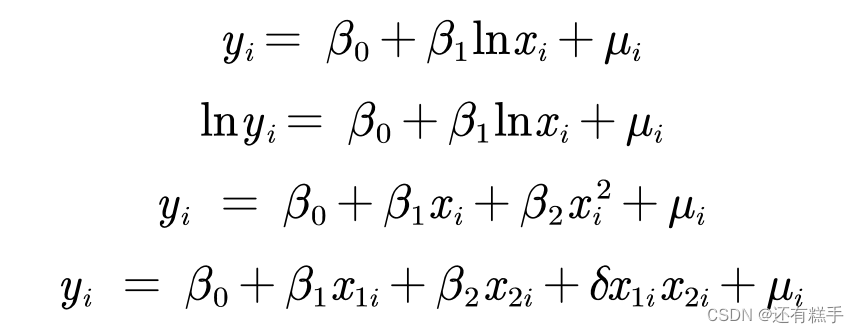


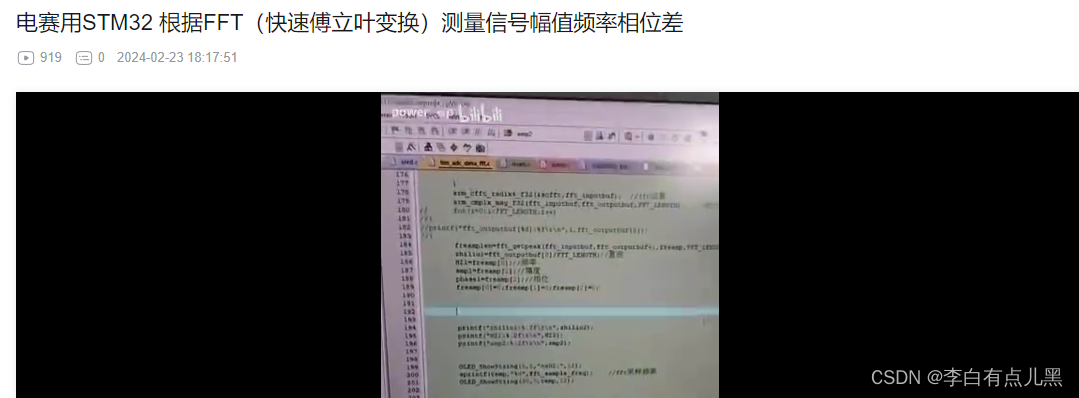

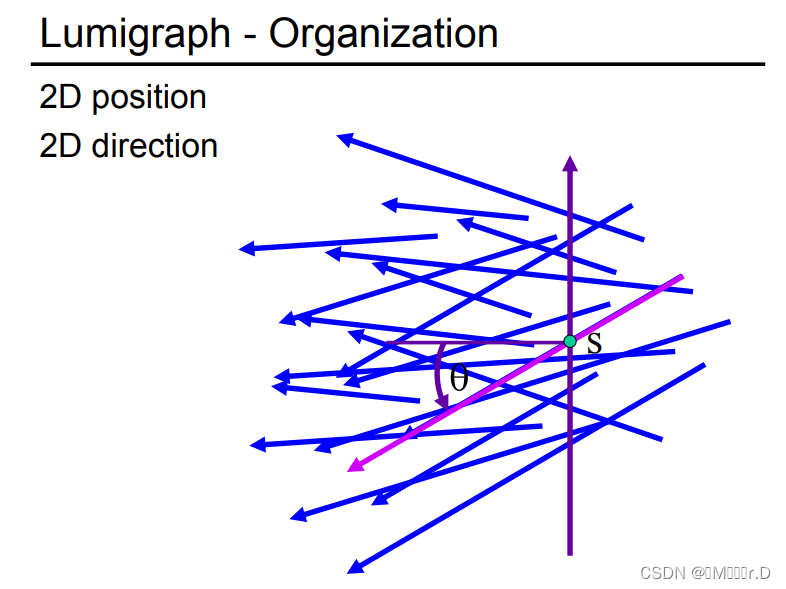

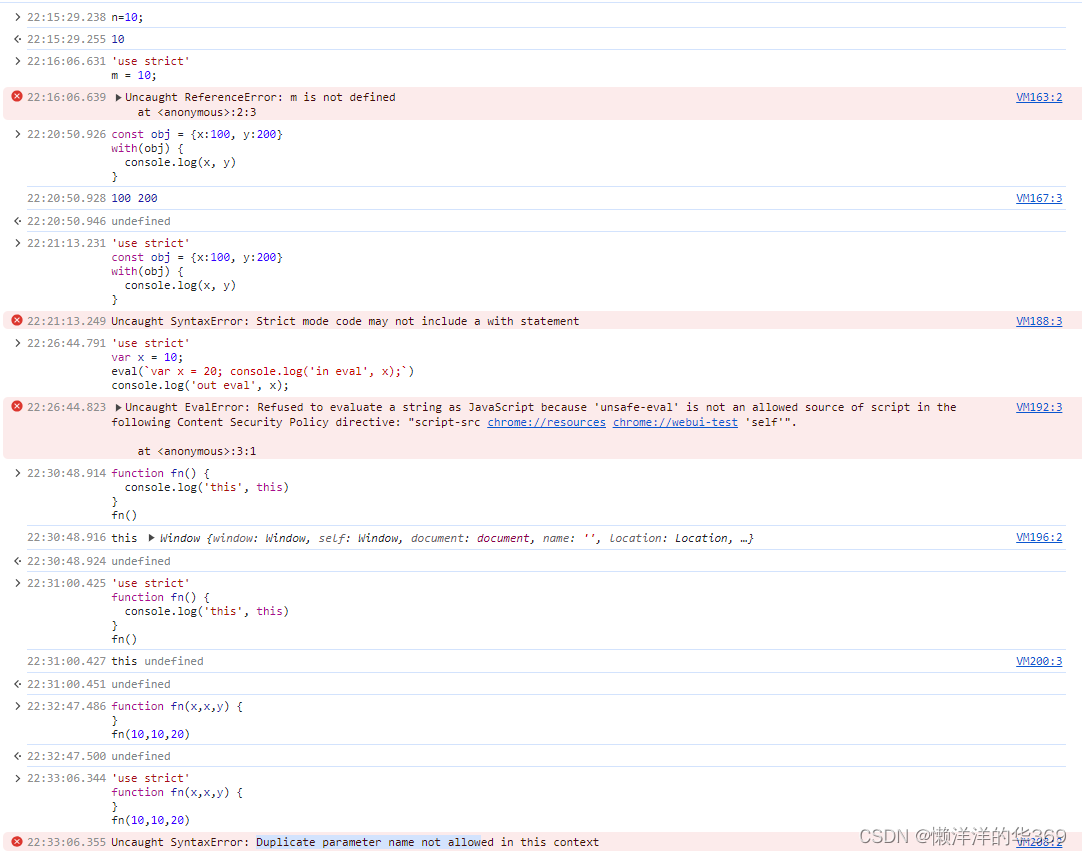
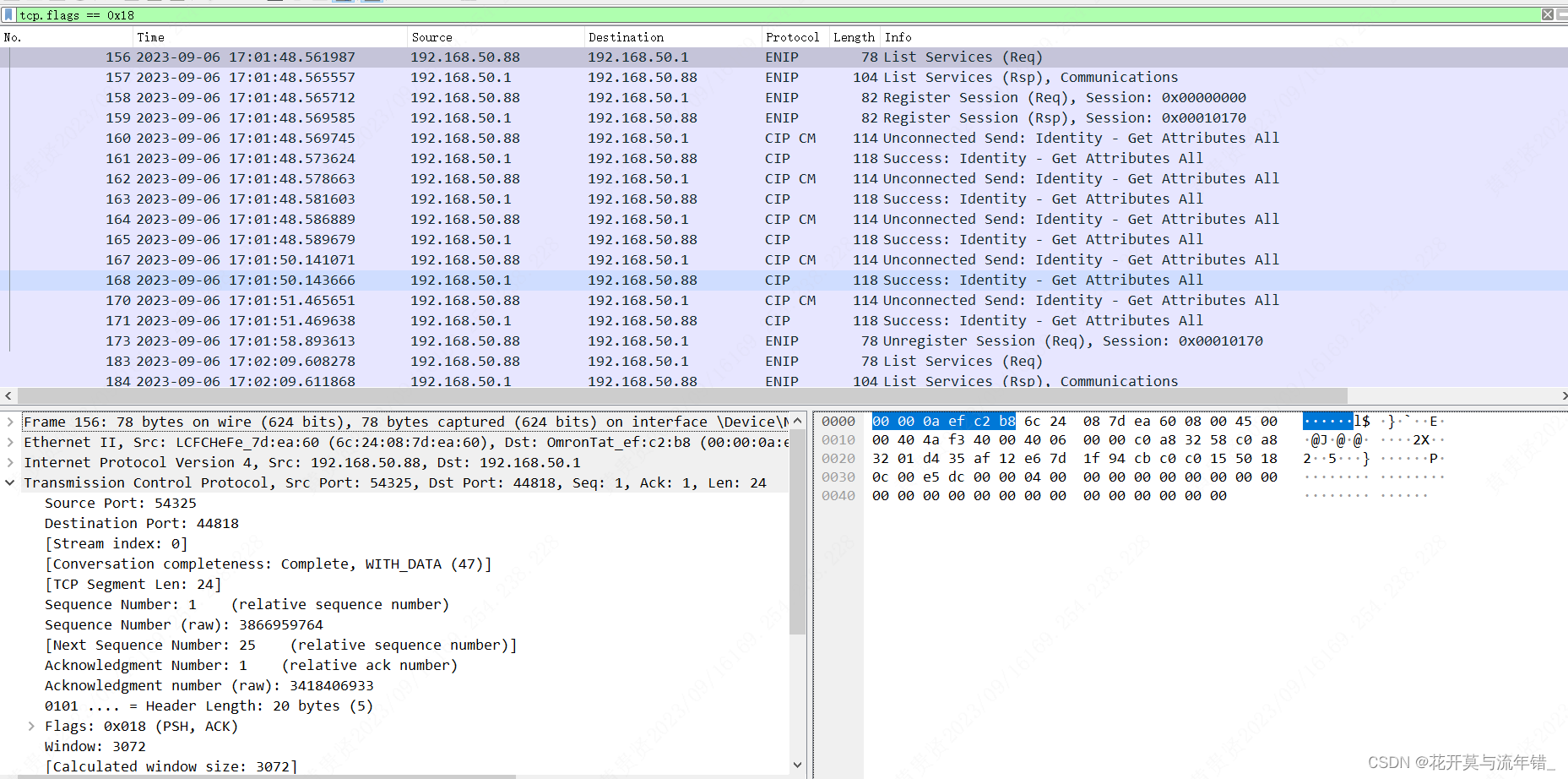
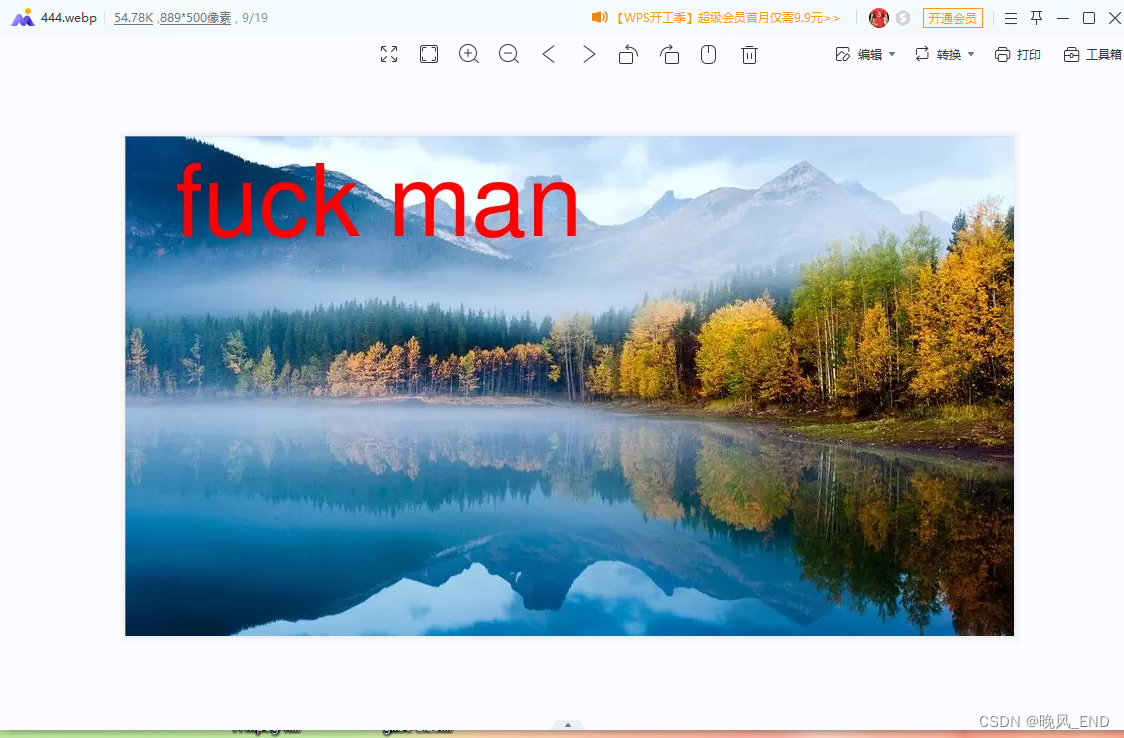
【独一无二】](https://img-blog.csdnimg.cn/direct/26bf3f20ad724b5cb2ad926e764872ab.png)
